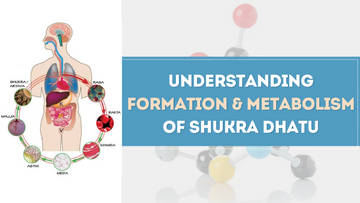
Introduction To Shukra Dhatu
According to Acharya Charaka, Vayu, Jala, Agni, and Prithvi are the other elements besides Akasha that make up Shukra. Acharya Chakrapani, who agrees with Acharya Charak, emphasizes that although Akash elements are present in Shukra, it is not present in Shukra because of their pervasiveness during ejaculation. Acharya Sushrut asserts that Soumya makes up most of Shukra, which contains all elements.
Locating Shukra Dhatu
According to Ayurveda, Shukra is located throughout the body because the juice from the sugarcane permeates the entire plant. Ghee, which is present in all parts of the sesame seed and can be extracted, makes up the entire curd, which is visible after it has been churned.
Shukra Rasa
Acharya Charaka asserts that Shukra encompasses all Shadrasas.
Predominating Dosha
Shukra is Ashray Sthan of Kapha Dosha, as Acharya Vagbhata correctly noted.
Functions of Shukra
Reproduction is Shukra Dhatu's primary function, but it also exhibits a variety of other functional traits.
These fall into the following categories:
- The systemic function of sarvadaihika.
- Maithunagata, a term connected to sexual activity.
- Roopa Dravyagata, e., seminal fluid-related functions.
- Additional features Shukra has a specific purpose in maintaining generations by creating healthy offspring. According to Sushruta Acharya, Beejartha, which means offspring production, is the main component of Shukra.
Understanding Shukra Dhatu
Infertility is the biological inability of a person to take part in conception. The discovery of infertility can lead to anxiety, worry, and depression. Infertility is associated with a number of medical, physiological, mental, emotional, societal, financial, and marital factors.
Situations. The loneliness and depression this challenge brings can sometimes push people to consider suicide. This ancient literature states that the Shukra Dhatu (reproductive tissue) in men and the Artava Dhatu commonly known as the Shukra in women is necessary for a healthy conception. This tissue may be affected by severe diseases, both physical and mental.
The formation of the Shukra Dhatu is the result of a protracted series of metabolic processes that start with digestion and end with the synthesis of blood, muscle, fat, bone, and bone marrow. The reproductive systems of both sexes should be healthy. Aberrations of this function, however, are a peculiarity of nature. Although procreation is essential for a species' survival and development, not all partners are able to grow their families. As a result, infertility is a problem that dates back to ancient cultures.
Spermatogenesis And Shukra Dhatu
Shukra Dhatu is derived from Majja Dhatu's Prasad Bhag by Shukra Dhatvagni. Due to the pores that Akash and Vayu have created in Asthidhatu, Shukra seeps out and spreads throughout the body like water from a fresh clay pot. Similar to this, during embryonic development, germ cells move to the testis where they differentiate into spermatogonia, which is still present on the inner surface of the testis. Spermatogonia then undergoes mitosis during puberty and becomes sperm.
Mental Health And Shukra
First and foremost, almost all hormonal imbalances are caused by deficiencies in Shukra, the seventh tissue level that gradually forms from the other six tissues. Any vitiation in Shukra will, through evolutionary metamorphosis, represent the chronic deficiency in the preceding Dhatus. The mind can also affect Shukra, which will negatively impact its byproduct, Ojas. The final tissue level, and subsequently Ojas, can be destroyed by a mental disturbance. Acharya Dalhana's analysis of Sushrut Mastihka or Mastulunga is known as Majja.
Since Shukra is created from Majja Dhatu, the brain and pituitary gland can be viewed as functional representations of Majja. As a result, any disturbance at the location of Majja Dhatu will affect its transformation into Shukra, which in turn will affect its byproduct, Ojas. Consequently, for the proper formation of Shukra, a balanced mind is necessary.
Shuddha Shukra And Semen
Shuddha Shukra Lakshanas refers to the attributes of Shuddha Shukra.
- Sphatikabha (Crystalline), Ghrita- Ksaudra-Taila- Nibha (Color that of ghee, honey, oil)
- Madhugandhi (Smelling like honey)
- Drava (Liquid), Picchila
- Bahu (Abundant), Bahala (Thick)
- Avisra (No bad smell), Shukla (White)
- Kaphavarga
- Madhura (Sweet), Snigdha (Unctuous).
- The term "Shatikabha" describes the sperm's white and transparent color.
- Bahu/Bahala represents the standard 1/2 Anjali Pramana's worth of sperm.
- Madhugandha is the name for the scent that each of its constituent parts gives off to sperm.
- Fructose in the seminal plasma is the cause of the madhura taste of Shukra.
- The term "Avidahi" refers to the pH of the sperm, which is characterized as neither an acidic nor a strongly alkaline pH, showing neither a burning sensation after ejaculation.
- According to various components of seminal plasma, characters like Drava (Fluid), Picchila (Swelling), Snigdha (Unctuous), and Sara (Liquid) demonstrate the average viscosity of semen.
- The propensity to flow out is frequently used to identify the semen discharged during the intense pleasure of copulation (Pravana Bhava).
Conclusion
The highest Sara in Ahara Rasa is Shukra. The molecule Shukra, which is released after ejaculation, is in charge of all systemic bodily processes, particularly metabolic ones. It is regarded as the foundation of all Dhatus. Its location throughout the body and its function—which is reproduction are Shukra and semen. Shukra Dhatu must be properly formed, which calls for a sound mental attitude.
AADAR with the principle of Ayurveda has always followed nature's path and tried to heal the world with most of the natural ingredients available om nature itself. In this Ayurvedic journey, AADAR has always strived to serve people with the best quality products that heal with long-lasting effects and no side effects.



